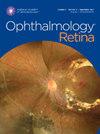Faricimab Treat-and-Extend Dosing for Macular Edema Due to Retinal Vein Occlusion
IF 5.7
Q1 OPHTHALMOLOGY
引用次数: 0
Abstract
Purpose
To assess the efficacy, durability, and safety of dual angiopoietin-2/VEGF inhibition with faricimab dosed per a modified treat-and-extend-based regimen in patients with retinal vein occlusion.
Design
Single-arm treatment period after a randomized, double-masked, active comparator-controlled period in the phase III BALATON/COMINO (NCT04740905/NCT04740931) trials.
Participants
Patients with treatment-naïve foveal center-involved macular edema due to branch (BALATON; N = 553) or central/hemiretinal (COMINO; N = 729) retinal vein occlusion.
Methods
Patients randomized to faricimab 6.0 mg every 4 weeks (Q4W) or aflibercept 2.0 mg Q4W up to week 20 received faricimab 6.0 mg dosed per a modified treat-and-extend-based regimen from week 24 to 72. The dosing frequency was adjusted from Q4W to Q16W based on changes in central subfield thickness (CST) and best-corrected visual acuity.
Main Outcome Measures
Change from baseline through week 72 in best-corrected visual acuity and CST; durability and safety through week 72.
Results
Visual acuity gains and CST reductions achieved at week 24 were maintained through week 72. Adjusted mean best-corrected visual acuity (95.03% confidence interval [CI]) changes from baseline averaged over weeks 64, 68, and 72 in the prior faricimab Q4W and prior aflibercept Q4W arms were +18.1 letters (16.9–19.4) and +18.8 letters (17.5–20.0), respectively, in BALATON and +16.9 letters (15.2–18.6) and +17.1 letters (15.4–18.8), respectively, in COMINO. Adjusted mean (95.03% CI) CST changes from baseline averaged over weeks 64, 68, and 72 in the prior faricimab Q4W and prior aflibercept Q4W arms were −310.9 μm (−315.6 to −306.3) and −307.0 μm (−311.7 to −302.3), respectively, in BALATON and −465.9 μm (−472.5 to −459.3) and −460.6 μm (−467.2 to −453.9), respectively, in COMINO. In the prior faricimab Q4W and prior aflibercept Q4W arms, 64.1% and 56.9% of patients from BALATON and 45.5% and 50.1% from COMINO, respectively, were on ≥Q12W dosing at week 68. Faricimab continued to be well tolerated from weeks 24 to 72; the safety profile was consistent with that established for diabetic macular edema and neovascular age-related macular degeneration.
Conclusions
These findings support the sustained efficacy and safety of faricimab in patients with macular edema due to retinal vein occlusion up to 72 weeks, with the potential for reduced treatment burden due to response durability.
Financial Disclosure(s)
Proprietary or commercial disclosure may be found in the Footnotes and Disclosures at the end of this article.
法利昔单抗治疗和延长剂量治疗视网膜静脉阻塞引起的黄斑水肿:来自BALATON和COMINO试验的72周结果
目的:评估法利西单抗对血管生成素-2/血管内皮生长因子双重抑制的有效性、持久性和安全性,这种双重抑制是基于改进的治疗和延长(T&E)方案的,用于视网膜静脉闭塞(RVO)患者。设计:BALATON/COMINO (NCT04740905/NCT04740931)三期试验随机、双盲、有效对照期后的单臂治疗期。参与者:treatment-naïve中央凹中心受累黄斑水肿患者(BALATON;N=553)或中央/半视网膜(COMINO;RVO N = 729)。方法:从第24-72周开始,随机分配到法利昔单抗6.0 mg每4周(Q4W)或afliberept 2.0 mg Q4W的患者接受法利昔单抗6.0 mg每改良t&based方案的剂量。根据中心子野厚度(CST)和最佳矫正视力(BCVA)的变化,调整给药频率Q4W-Q16W。主要结局指标:BCVA和CST从基线到第72周的变化;第72周的耐久性和安全性。结果:视力的提高和CST的降低在第24周保持到第72周。在先前faricimab Q4W组和先前aflibercept Q4W组中,64/68/72周的调整后平均BCVA (95.03% CI)从基线平均变化分别为+18.1个字母(16.9至19.4)和+18.8个字母(17.5至20.0),在BALATON组和COMINO组中分别为+16.9个字母(15.2至18.6)和+17.1个字母(15.4至18.8)。在先前faricimab Q4W组和aflibercept Q4W组中,经过64/68/72周的调整平均(95.03% CI) CST从基线的平均变化分别为-310.9 μm(-315.6至-306.3)和-307.0 μm(-311.7至-302.3),BALATON组和COMINO组分别为-465.9 μm(-472.5至-459.3)和-460.6 μm(-467.2至-453.9)。在先前的faricimab Q4W组和afliberept Q4W组中,BALATON组64.1%和56.9%的患者以及COMINO组45.5%和50.1%的患者在第68周时的剂量≥Q12W。Faricimab在第24-72周持续耐受良好;安全性与糖尿病性黄斑水肿和新生血管性年龄相关性黄斑变性一致。结论:这些研究结果支持faricimab对RVO引起的黄斑水肿患者长达72周的持续有效性和安全性,并且由于反应持久性而有可能减轻治疗负担。
本文章由计算机程序翻译,如有差异,请以英文原文为准。
求助全文
约1分钟内获得全文
求助全文

 求助内容:
求助内容: 应助结果提醒方式:
应助结果提醒方式:


